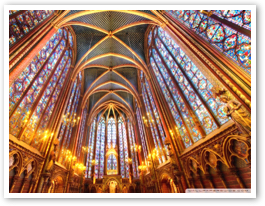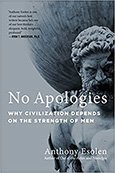How the Church Has Changed the World: For God is Light
- ANTHONY ESOLEN
There has never been a more playful and light-filled and healthily popular architecture than that of the Gothic cathedrals.
Join the worldwide Magnificat family by subscribing now: Your prayer life will never be the same!
 It's one of the sad ironies of our time that the word "Gothic" now describes an adolescent and antisocial madness, wearing black, as if the whole world were one great funeral, dyeing your hair purple, as if chestnut and auburn were too mild to endure, and piercing your body with rings and spikes, as if you had just been stretching prisoners on a rack. Perhaps all the grime deposited upon churches during the Industrial Revolution gave us the wrong impression. It's hard for marble to gleam when the coke furnaces are burning day and night. It's hard for stained-glass windows to flourish their brilliant colors in smog.
It's one of the sad ironies of our time that the word "Gothic" now describes an adolescent and antisocial madness, wearing black, as if the whole world were one great funeral, dyeing your hair purple, as if chestnut and auburn were too mild to endure, and piercing your body with rings and spikes, as if you had just been stretching prisoners on a rack. Perhaps all the grime deposited upon churches during the Industrial Revolution gave us the wrong impression. It's hard for marble to gleam when the coke furnaces are burning day and night. It's hard for stained-glass windows to flourish their brilliant colors in smog.
But there's never been a more playful and light-filled and healthily popular architecture than that of the Gothic cathedrals — soaring draperies of stone and glass, their slender exterior supports like spokes of a wheel, nothing merely functional, everything touched by human hands, embracing every artistic impulse, from the whimsy of the mason to the vision of the mystic.
Where was it born? All over Europe and in the hearts of Christians; but if we have to choose one place and one man, it must be Paris and Abbot Suger (1081-1155).
The Man in Charge
"But my Lord Abbot," says the master builder, "we can't leave all that space open. It's too wide. We don't have the timber that will do for the vaults above."
"We'll find it then," says the abbot, an old man even by our standards. So Suger went with his builder and their sawyers to the forests outside of Paris, and they searched and searched until they found trees tall enough to serve, much to the surprise of everyone but the good abbot.
I like that little anecdote because it reveals a great deal about him. Suger was the man in charge, the man who got things done. Against his advice, King Louis VI went on the second Crusade, leaving Suger at home to deal with his rebellious noblemen, but Suger was so wise and competent as regent that when Louis returned he named him the Father of the Country.
Suger had been dedicated to the royal Abbey of Saint Denis from the time he was a boy. He was something of an ecclesiastical worldling in his youth, until he heard Saint Bernard of Clairvaux and his trumpet call for monastic reform. As abbot he introduced those reforms at Saint Denis, and he heeded Bernard's criticism of the soul-confusing art that festooned the wealthy monastery of Cluny. Here's the inimitable Bernard:
But in the cloister, under the eyes of the brethren who read there, what profit is there in those ridiculous monsters, in the marvelous and deformed comeliness, that comely deformity? To what purpose are those unclean apes, those fierce lions, those monstrous centaurs, those half-men, those striped tigers, those fighting knights, those hunters winding their horns?... We are more tempted to read in the marble than in our books, and to spend the whole day in wondering at these things rather than in meditating the love of God.
Neither Bernard nor Suger meant that churches should be drab and paltry. Far from it! They wanted not churches as showplaces for art, but art as an instrument for lifting the heart and mind to God. So when the old Abbey of Saint Denis had to be rebuilt, Suger aimed to flood the interior with light both clear and colored, and with gold and jewels, reflectors and repositories of light. God is light, says Saint John, and in him there is no darkness at all (1 Jn 1:5).
A Theology and Architecture of Light
Let's consider his choice for a moment. Light is the first of God's creations — what does that mean? The sacred author doesn't tell us that God first made the sun and stars, objects that give light He first made light: as if of all created things, light, intellectual light, is the closest to his being, who alone has immortality, who dwells in unapproachable light (1 Tm 6:16). Then, too, a happy coincidence made light the fittest of Suger's aims. The patron of France was Saint Dionysius (Denis), a bishop martyred in the third century. He shared the same name with the Dionysius whom Saint Paul converted in Athens, and with an unknown Syrian monk, using the pseudonym Dionysius, who wrote mystical tracts regarding the names of God and the hierarchies of the angels. That monk's theology, to put it simply, is a poetry of light, of the pouring forth of being and light from God whom no mere creature can fathom.
All of that set Suger's busy mind to work.
How do you bring light into the abbey? Build high walls for a vast open space within. Build with strong interlocking ribs and pointed arches above, to direct the weight down without relying so much upon the walls for support. Brace those walls from without, not within. Replace wall with glass — tall, airy windows. Fill the windows with color. Embed the upper altar with gold and jewels, thought to have been produced in the earth by the fruitful power of the sun. People the niches with saints and kings and queens of France. Show everywhere the light of Christ and his works upon earth and in heaven. Let the whole gleaming white structure resemble a great jewelry box, a soaring gift of God to man and man to God.
The Abbot Speaks to Us
That's what Abbot Suger thought. Here are the verses he had carved upon the gilded doors:
All you who seek to honor these doors,
Marvel not at the gold and the cost but at the art.
The noble work is bright but being nobly bright, the work
Should brighten minds, allowing them to travel through the lights
To the true light, where Christ is the true door.
The golden door shows how it is immanent in these things.
The dull mind rises to the truth through material things,
And rises from its submersion when it sees the light
And it wasn't just that he expected people to make an abstract leap from earthly light to heavenly light. He wanted also, in the art, to show them how Christ our Light is present in the world. We might say that the whole of a Gothic cathedral is a door, leading us to Christ by its beautiful and orderly exposition of the glorious work of God.
So Suger ordered a series of stained-glass windows, under each of which he appended verses that tell us how what we see should help us to rise from the material to the immaterial, or from the shadow of the Old Testament to the noon-day light of the New. Most curious among these windows is one of Saint Paul, working at a mill — of all things! He's pouring the grain into the hopper so that flour will come forth:
By working the mill, Paul, you take the flour from the bran.
You make known the inner meaning of Moses' law
From so many grains is made the true bread without bran,
The perpetual food of men and angels.
That's what we are to do when we "read" the art of the cathedral. Suppose we are kneeling before the brilliant tabernacle where our Lord dwells under the species of bread and wine. Its golden panel is studded with sapphires, amethysts, rubies, emeralds, and pearls, many of them given by the lords and ladies of France as offerings to God, to be owned, as it were, by God and by all the faithful, rich and poor. All might kneel there before the Lord. Suger's verses on the panel teach us how to orient our hearts, since even this glorious Eucharistic table is but a reflection of the heavenly banquet to come, and "that which is signified pleases more than that which signifies." The art, the signs, are filled with beauty; and they direct our gaze to Beauty himself.
A New Thing in the World
What was it like to sit and pray in that lacework castle of praise? Imagine the abbot, that energetic old man, taking an hour from his cares of Church and state. He enters Saint Denis, approaches the sanctuary, and stands bathed in light. Let the man himself describe his feelings:
Thus sometimes when, because of my delight in the beauty of the house of God, the multicolor loveliness of the gems has called me away from external cares, and worthy meditation, transporting me from material to immaterial things, has persuaded me to examine the diversity of holy virtues, then I seem to see myself existing on some level, as it were, beyond our earthly one, neither completely in the slime of earth nor completely in the purity of heaven.
Abbot Suger sought the things of heaven first, and the things of earth were given to him in the bargain. He sought to praise God and his country's patron, Saint Denis, in the finest way he knew. Those were the things of heaven; what happened was no less than that he and the men who followed his lead renewed the art of Europe, and graced the world with its noblest buildings, meant for every man and woman and child, because they were meant for God first.
And when Suger died, Saint Bernard gave us an epitaph that was as apt as it was heartfelt. Writing to their good friend Pope Eugenius, he said, "If there is any precious vase adorning the palace of the King of Kings, it is the soul of the venerable Suger." Let us too aspire to be art for God.
 This is J. Fraser Field, Founder of CERC. I hope you appreciated this piece. We curate these articles especially for believers like you.
This is J. Fraser Field, Founder of CERC. I hope you appreciated this piece. We curate these articles especially for believers like you.
Please show your appreciation by making a $3 donation. CERC is entirely reader supported.

Acknowledgement
 Anthony Esolen. "How the Church Has Changed the World: For God is Light." Magnificat (April, 2015).
Anthony Esolen. "How the Church Has Changed the World: For God is Light." Magnificat (April, 2015).
Join the worldwide Magnificat family by subscribing now: Your prayer life will never be the same!
To read Professor Esolen's work each month in Magnificat, along with daily Mass texts, other fine essays, art commentaries, meditations, and daily prayers inspired by the Liturgy of the Hours, visit www.magnificat.com to subscribe or to request a complimentary copy.
The Author

Anthony Esolen is writer-in-residence at Magdalen College of the Liberal Arts and serves on the Catholic Resource Education Center's advisory board. His newest book is "No Apologies: Why Civilization Depends on the Strength of Men." You can read his new Substack magazine at Word and Song, which in addition to free content will have podcasts and poetry readings for subscribers.
Copyright © 2015 Magnificat

